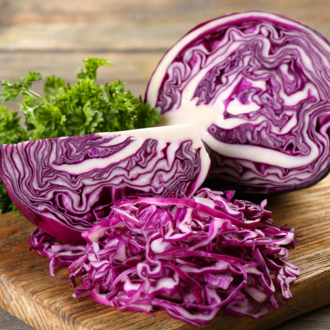Cabbage
In the Fraser valley we have 4 types of cabbage: green, red, Savoy and Taiwanese. Other vegetables in the cabbage or cruciferous family include Brussels sprouts, broccoli, cauliflower and kale. Cabbage is in season in Canada from July to December. Cabbage is very low in calories, fat and high in fibre. 1 cup shredded cabbage contains 18 calories, 2 g of fibre and 70% of your daily vitamin C requirements. Additionally, cabbage is famous for a specialized, naturally occurring, nitrogenous compound known as indoles. Current research indicates that indoles can lower the risk of various forms of cancer. Cabbage also plays a role in the inhibition of infections and ulcers. Cabbage extracts have been proven to kill certain viruses and bacteria in a laboratory setting. Cabbage boosts the immune system's ability to produce more antibodies. It also provides high levels of iron and sulfur, minerals that work in part as cleansing agents for the digestive system. The pungent smell you get from cooking cabbage is from the sulfur compounds released with heating.
Buying and Storing:
For green and red cabbage look for round, firm, compact heads that are smooth and heavy for their size. For Savoy, look for a good colour green with crinkly leaves and heavy for their size. Taiwanese you should look for a flat head with a diameter of 10-12 inches. BCFresh cabbage is hand harvested, trimmed and packed to order in the field.
Cabbages are best kept refrigerated. They lose their moisture easily so trim outer leaves just prior to cooking as the outer leaves help to prevent moisture loss. Try not to buy cabbage halves or quarters as the cut leaves lead to vitamin C loss. Keep them stored in a perforated plastic bag to allow moisture to escape. An uncut head of green or red cabbage will last for 2 weeks no problem. Once you do cut the cabbage, be sure to cover the cut surface tightly with plastic wrap.
Preparing:
Rinse cabbage in cold water to get rid of any dirt. Cabbage does not need to be cooked for long as it will lose vitamin C. It should be served as soon as possible after cooking. Typically cabbage is sliced or shredded and this is done easily if you cut the head into 4 and keep the core on so it holds the leaves in place when you slice or grate it.
Cooking:
Boiling: 2-3 minutes for shredded cabbage. Consider using the water for soup after.
Braising: Using just enough water to cover the cabbage, boil and simmer in a Dutch oven. Try using chicken stock, apple cider, apple juice or wine, onions or shallots for flavour.
Cabbage can also be microwaved, steamed or stir fried.
Meal Ideas:
Try shredded purple cabbage in a sandwich or wrap instead of lettuce
Make a shredded cabbage salad with Asian dressing such as soy sauce, rice wine vinegar, garlic, ginger and sesame oil.
Add shredded cabbage to soups, stews or braised as a side dish.















